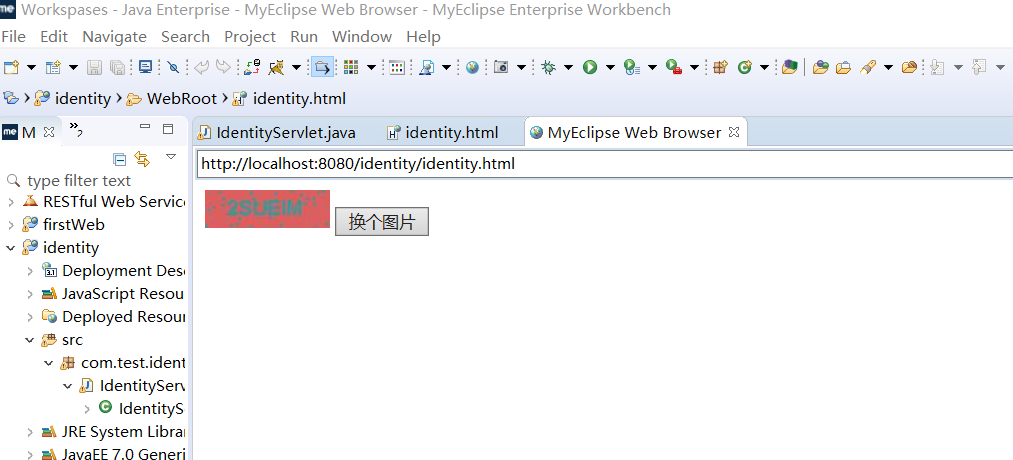First, create a Java Web project named identity, and create a new Servlet named IdentityServlet below it. If the project and Servlet will not be created, please refer to my notes in the previous section: https://blog.csdn.net/h2503652646/article/details/82555695
Here is the source code of IdentityServlet.java
package com.test.identity;
import java.awt.Color;
import java.awt.Font;
import java.awt.Graphics2D;
import java.awt.image.BufferedImage;
import java.io.IOException;
import java.io.PrintWriter;
import java.util.Random;
import javax.servlet.ServletException;
import javax.servlet.ServletOutputStream;
import javax.servlet.http.HttpServlet;
import javax.servlet.http.HttpServletRequest;
import javax.servlet.http.HttpServletResponse;
import com.sun.image.codec.jpeg.JPEGCodec;
import com.sun.image.codec.jpeg.JPEGImageEncoder;
public class IdentityServlet extends HttpServlet {
public static final char[] CHARS={'2','3','4','5','6','7','8','9',
'A','B','C','D','E','F','G','H','I','J','K',
'L','M','N','U','V','W','X','Y','P','Q','R',
'S','T','Z'}; //These are the verification code content generated randomly on the picture
public static Random random=new Random();
//Method of obtaining 6-bit random character verification code
public static String getRandomString(){
StringBuffer buffer=new StringBuffer();
for(int i=0;i<6;i++){
buffer.append(CHARS[random.nextInt(CHARS.length)]);
}
return buffer.toString();
}
//Random colors
public static Color getRandomColor(){
return new Color(random.nextInt(255),random.nextInt(255),random.nextInt(255));
}
//The reverse of a color, used in the foreground
public static Color getReverseColor(Color c){
return new Color(255-c.getRed(),255-c.getGreen(),255-c.getBlue());
}
/**
* Constructor of the object.
*/
public IdentityServlet() {
super();
}
/**
* Destruction of the servlet. <br>
*/
public void destroy() {
super.destroy(); // Just puts "destroy" string in log
// Put your code here
}
/**
* The doGet method of the servlet. <br>
*
* This method is called when a form has its tag value method equals to get.
*
* @param request the request send by the client to the server
* @param response the response send by the server to the client
* @throws ServletException if an error occurred
* @throws IOException if an error occurred
*/
public void doGet(HttpServletRequest request, HttpServletResponse response) throws ServletException, IOException {
response.setContentType("image/jpeg");
String randomString=getRandomString(); //Random string
request.getSession(true).setAttribute("randomString", randomString);
int width=100;
int height=30;
Color color=getRandomColor();
Color reverse=getReverseColor(color); //Reverse, for foreground
BufferedImage bi=new BufferedImage(width,height,BufferedImage.TYPE_INT_RGB);
Graphics2D g=bi.createGraphics();
g.setFont(new Font(Font.SANS_SERIF,Font.BOLD,16));
g.setColor(color);
g.fillRect(0, 0, width, height);
g.setColor(reverse);
g.drawString(randomString, 18, 20); //Draw random characters
for(int i=0, n=random.nextInt(100);i<n;i++){
//Draw up to 100 noise points
g.drawRect(random.nextInt(width), random.nextInt(height), 1, 1); //Noise points are generated by randomly selecting positions on pictures
}
ServletOutputStream out=response.getOutputStream();
JPEGImageEncoder encoder=JPEGCodec.createJPEGEncoder(out); //Convert to JPEG format
encoder.encode(bi); //Encode pictures
out.flush();
}
/**
* The doPost method of the servlet. <br>
*
* This method is called when a form has its tag value method equals to post.
*
* @param request the request send by the client to the server
* @param response the response send by the server to the client
* @throws ServletException if an error occurred
* @throws IOException if an error occurred
*/
public void doPost(HttpServletRequest request, HttpServletResponse response) throws ServletException, IOException {
response.setContentType("text/html");
PrintWriter out = response.getWriter();
out.println("<!DOCTYPE HTML PUBLIC \"-//W3C//DTD HTML 4.01 Transitional//EN\">");
out.println("<HTML>");
out.println(" <HEAD><TITLE>A Servlet</TITLE></HEAD>");
out.println(" <BODY>");
out.print(" This is ");
out.print(this.getClass());
out.println(", using the POST method");
out.println(" </BODY>");
out.println("</HTML>");
out.flush();
out.close();
}
/**
* Initialization of the servlet. <br>
*
* @throws ServletException if an error occurs
*/
public void init() throws ServletException {
// Put your code here
}
}
Next, we create an HTML file to reference the image verification code. The creation method is: right click on the project identity and select New - HTML (Advanced templates), set the name to identity in the pop-up box, and then Finish. The following is the code of identity.html:
<!DOCTYPE HTML PUBLIC "-//W3C//DTD HTML 4.01 Transitional//EN">
<meta http-equiv="content-type" content="text/html; charset=UTF-8">
<script>
function reloadImage(){
document.getElementById('btn').disable=true;
document.getElementById('identity').src='servlet/IdentityServlet?ts='+new Date().getTime();
}
</script>
<img src="servlet/IdentityServlet" id="identity" onload="btn.disabled =false; "/>
<input type=button value="Change a picture." onclick="reloadImage()" id="btn">After all the code work is completed, deploy the project on your own Tomcat (refer to the notes in the previous section for the deployment method), start tomcat, and enter:
http://localhost:8080/identity/identity.html Enter, the effect is as follows:

Click the button to refresh and replace the verification code.